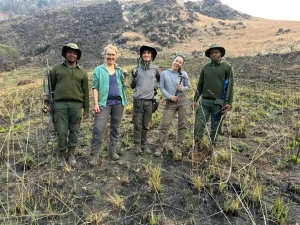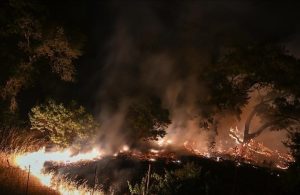
A colossal meteorite, first identified in 2014, has been linked to a historic tsunami and the boiling of Earth’s oceans, according to recent scientific discoveries. This meteorite, dubbed S2, was 200 times larger than the asteroid that contributed to the extinction of the dinosaurs. It collided with our planet during its formative years, approximately three billion years ago.
To study this ancient impact, researchers, led by Professor Nadja Drabon from Harvard University, trekked to the Eastern Barberton Greenbelt in South Africa. Equipped with sledgehammers, the team chiseled samples from the impact site to gain insights into the event’s ramifications.
Prof. Drabon explains that, following Earth’s formation, the planet was still bombarded by celestial debris. “We now know that life demonstrated remarkable resilience after some of these massive impacts, actually flourishing in their aftermath,” she states.
Unlike the more familiar asteroid that decimated the dinosaurs 66 million years ago, measuring about 10 kilometers in diameter, the S2 meteorite was significantly larger, ranging from 40 to 60 kilometers wide. Its mass was estimated to be 50 to 200 times greater than that of the dinosaur-killing asteroid.
At the time of the S2 impact, Earth was predominantly covered by water, with only a few landmasses emerging. The dominant life forms were simple single-celled microorganisms. The impact site in South Africa is among the oldest evidence of a meteorite crash on Earth.
Professor Drabon and her colleagues undertook multiple expeditions to the remote mountains, often accompanied by armed rangers to safeguard against wildlife and potential poachers. Their mission was to locate spherule particles—tiny remnants from the impact. They collected hundreds of kilograms of rock, which were later analyzed in laboratories.
Notably, Prof. Drabon carefully packed the most valuable samples in her luggage for transport, often garnering attention at airport security. “I typically explain the significance of the science, and they quickly lose interest and let me through,” she shares.
Through meticulous analysis, the team reconstructed the catastrophic events caused by the S2 meteorite. Upon impact, it created a 500-kilometer-wide crater, ejecting pulverized rock at astonishing speeds. This ejected material formed a cloud that encircled the globe, akin to a rain cloud—but with molten rock instead of water droplets, as described by Prof. Drabon.

The impact generated a colossal tsunami that swept across the planet, devastating coastlines and tearing up the seabed. The sheer energy released would have dwarfed even the most significant tsunamis recorded in human history, such as the 2004 Indian Ocean tsunami.
The enormous heat generated from the impact caused the oceans to boil, evaporating tens of meters of water and raising air temperatures by as much as 100°C. The skies would have darkened with dust and particles, blocking sunlight and potentially wiping out photosynthetic life forms both on land and in shallow waters.
While such impacts typically spell doom for life, Prof. Drabon and her team uncovered surprising evidence indicating that these violent disturbances could have catalyzed life’s resurgence. Analysis revealed that the impacts churned up essential nutrients, including phosphorus and iron, nourishing early organisms.
“Life not only survived but thrived in these new conditions,” Prof. Drabon states. She likens this resilience to the rapid regrowth of bacteria after brushing teeth. “It’s like killing 99.9% of bacteria; by evening, they’re back,” she explains.
The research suggests that these catastrophic events acted as a sort of natural fertilizer, distributing vital elements needed for life across the planet. The tsunami would have also facilitated the mixing of nutrient-rich deep ocean waters with surface waters, providing energy to early microbial life.
These findings contribute to a growing understanding among scientists that early life on Earth benefited from the cataclysmic impacts it experienced. As Prof. Drabon summarizes, “After these impacts, life encountered conditions that allowed it to flourish.”
The implications of this research are detailed in the scientific journal PNAS, highlighting the dual role of such impacts in Earth’s geological and biological history.







